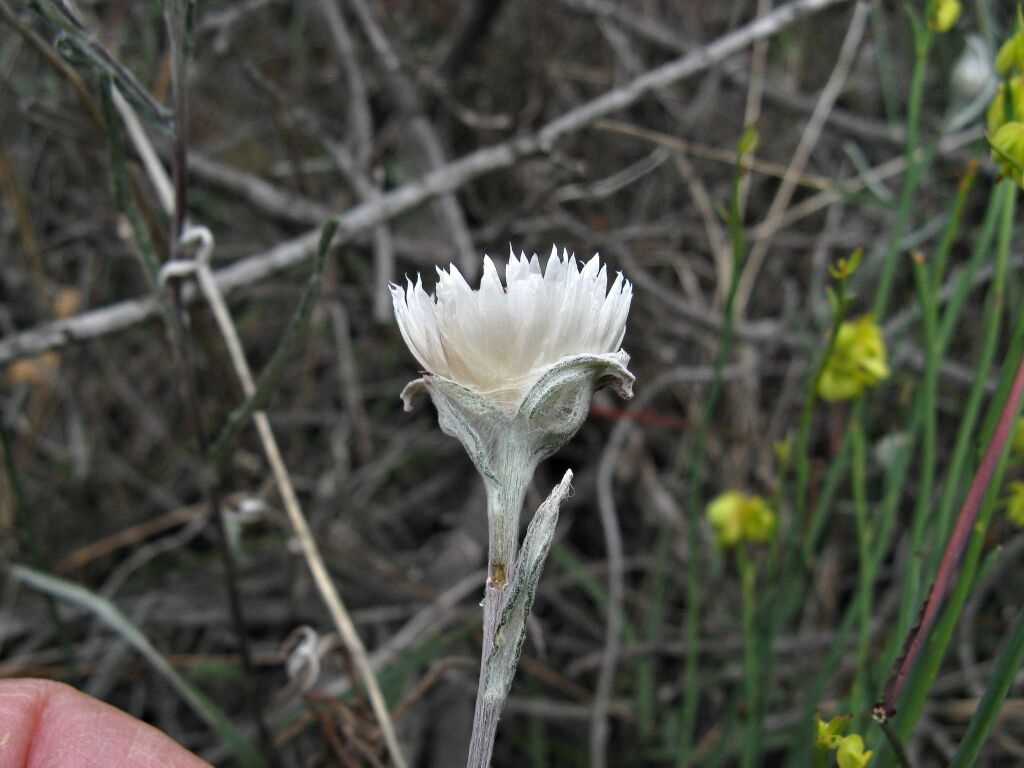Helichrysum
Annual, biennial or perennial herbs, subshrubs or shrubs, usually woolly or cobwebby, often glandular as well, rarely glabrous. Leaves cauline, petiolate or sessile, alternate, entire. Capitula campanulate to narrow-cylindric or depressed-globose, terminal, solitary or many in corymbs, subsessile or pedunculate; involucral bracts in several series, unequal, papery, brown, yellow, pink or white; stereome divided; receptacle flat, usually naked, rarely paleate, pitted or not, often fimbrilliferous. Florets all bisexual or outer ones female, yellow; corolla deeply 5-lobed (females 2–4-lobed); anthers tailed at base with lanceolate apical appendages; style bilobed, with truncate and penicillate branches. Cypselas obloid, glabrous or hairy; pappus of smooth hairs or barbellate or subplumose bristles, free or fused at base, usually uniseriate, rarely biseriate or absent.
c. 600 species, mainly from Africa; 5 species currently recognised in Australia.
Helichrysum Mill. once accommodated species with a divided stereome of the involucral bracts and a larger number of bisexual florets than female florets including many Victorian species now transferred to several other genera including Argentipallium Paul G. Wilson, Chrysocephalum Walp., Coronidium Paul G. Wilson, Ozothamnus R. Br., and Xerochrysum Tzvelev (Schmidt-Lebuhn et al. 2015).
African as well as Mediterranean species of Helichrysum have been shown to be closely related and part of a group that also includes other similar genera such as Achyrocline (Less.) DC., Anaphalis DC., and Pseudognaphalium Kirp (Galbany-Casals et al. 2014). This group does not include the Australian genera previously mentioned that were once included in Helichrysum confirming that they were misplaced in Helichrysum (Schmidt-Lebuhn et al. 2015). However, relationships within this large group of Helichrysum species and related genera are not fully understood and a more satisfactory circumscription of Helichrysum awaits better resolution of these relationships.
Of the five Australian species currently placed in Helichrysum only one, Helichrysum luteoalbum (L.) Rchb., has been shown to be part of the large group of closely related African Helichrysum and related genera and hence potentially justified as being retained within Helichrysum. However, it has also been included in Pseudognaphalium and there is uncertainty about whether it should be placed in Helichrysum or left in Pseudognaphalium (Galbany-Casals et al. 2014). The other Victorian Helichrysum, H. leucopsideum has been shown to be most closely related to Coronidium adenophorum (F.Muell.) Paul G. Wilson and C. waddelliae (J.H.Willis) Paul G. Wilson and is misplaced in Helichrysum (Schmidt-Lebuhn et al. 2015). However, the future circumscription and fate of Coronidium is uncertain (see notes under Coronidium) and this species is temporarily retained within Helichrysum.
The description given for Helichrysum here encompasses African Helichrysum and close relatives potentially part of Helichrysum s.str.
Jeanes, J.A. (1999). Asteraceae. In: Walsh, N.G.; Entwisle, T.J., Flora of Victoria Vol. 4, Cornaceae to Asteraceae, pp. 652–666. Inkata Press, Melbourne.
 Spinning
Spinning


